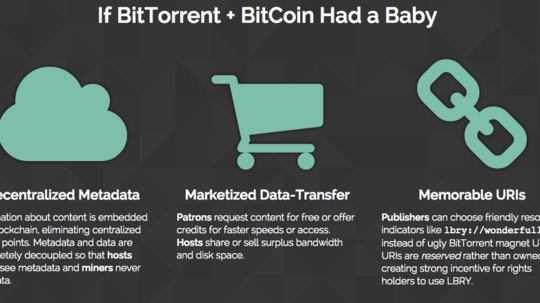
Here's a bold idea: If you're hosting a downloadable video file through a file-sharing protocol like BitTorrent, shouldn't you be entitled to some compensation? The New Hampshire-based creators of LBRY think so, which is part of why they're developing a new protocol that is equal parts BitTorrent and Bitcoin.
"With time, the fundamental difference between Netflix and LBRY is cheaper way to access content and a better experience."
With popularity soaring for Netflix, Spotify and other content streaming services, LBRY's small team thinks they're onto something that will eventually make the protocol better than everything else: the decentralization of content — meaning that publishers can sell their content directly to consumers without a middleman, and the content is hosted across hundreds of users instead of a few central servers.
"With time, the fundamental difference between Netflix and LBRY is cheaper way to access content and a better experience," said Jeremy Kauffman, one of LBRY's co-founders who also founded sports event management startup TopScore.
Kauffman started the project with Jimmy Kiselak, a former defense contractor, and Mike Vine, founder and principal of a financial services marketing consultancy. All three of them are participants in the Free State Project, a movement that seeks to recruit 20,000 libertarians to move to New Hampshire to create a community of people who believe in limited government.
However, Kauffman said, LBRY is first and foremost a for-profit venture.
"This is a business. Not a political project," he said. "But it’s certainly inspired by my philosophy."
So how does it actually work?
On LBRY's website, the developers give an idea of how this works:
- Ernest wants to release his comedy-horror film, "Ernie Goes To Guantanamo Bay."
- The content is encrypted and sliced into many pieces. These pieces are stored by hosts.
- Ernest reserves lbry://erniebythebay, a shortname pointing to his content.
- When Ernest reserves the location, he also submits metadata, such as a description and thumbnail. This information is stored by miners in the LBRY blockchain.
- Hilary, a patron, browses the LBRY network and wants to watch the movie. Her LBRY client collects the pieces from the hosts and reassembles them.
- Hilary pays Ernest for the decryption key, allowing her to watch the film.
The LBRY team showed BostInno an early version application built with the LBRY protocol. It was simple window with a search field in which you could type in the name of a file you're looking for. Once the filename was entered, it would return the file's metadata and you would then be able to open the file, which happened almost instantly when they clicked on it.
In a teaser video on LBRY's website, the developers show a proof-of-concept that allows you to watch a movie just by clicking a button on the movie's IMDB page. Kauffman said any LBRY proof-of-concept applications will be open source, so it's conceivable that a LBRY application with a user interface similar to Netflix or Hulu could eventually pop up.
CLIP: A proof-of-concept video showing LBRY functionality with IMDB.
Who will making money off of this?
While LBRY is being designed to let consumers buy content directly from publishers, the protocol is also being set up to incentivize users to host the content on their hard drive space or offer processing power in exchange for cryptocurrency. In LBRY's terms, the hosts are called "hosts" and the users offering processing power are called "miners."
If you're still trying to figure out the relation between LBRY's uploaded content and its cryptocurrency, the team explains it as such in their business plan:
Each percentage of the currency can be thought of as having a value proportional to the sum of all information transacted through the network.
All of the files uploaded to LBRY's network are split up and encrypted into tiny chunks of information across all of the network's hosts, so that no one user is liable for the content and prevents from being liable for what LBRY's team calls "draconian censorship laws." The miners mine the network's blockchain, which contains the metadata for every file, so that whenever a consumer looks up a specific file, the miners' processing power is used to process that request.
"A big part of this project is the leveraging of unused resources," whether that's hard drive space or processing power, Kauffman said, likening LBRY to how Airbnb and Uber figured out how to utilize the unused resources of homes and cars, respectively.
As for how LBRY's team will make money, Kauffman explained that once LBRY is officially launched, which is expected to happen sometime in Q4, the team will reserve 7.5 percent of the 1 billion LBRY credits set up on the system for operating costs. He said the team is still trying to determine the starting exchange rate for U.S. dollars, though the team is currently leaning towards the thought that one credit would equal one penny.
To encourage early adoption, Kauffman said the team also plans to set aside a certain amount of free credits for publishers and users.
What about piracy concerns?
Kauffman said the team doesn't want LBRY to be used for illegal activities, but acknowledges that since LBRY is a protocol like BitTorrent, illegal sharing is a possibility. Based on the team's understanding from their legal advisor, he added, the people who would be most liable for any unauthorized content on the network are those who upload or consume it.
To make sure that the system is optimized for publishers of authorized content, Kauffman said LBRY reserves shortnames (the address used to access the content) for whoever can pay the most credits. The LBRY explains its justification for this in its business plan:
"Because a name should always bring the most value to the legitimate content creator, the Coase theorem informs us that this design should ensure optimal and legitimate name distribution. It also creates incentive for content creators to join the network."
Along with giving free credits to publishers who are early adopters, Kauffman said he thinks this plan will work: "We think the economic design of the system puts an incentive for publishers to put their content on LBRY."
Images and video provided.








